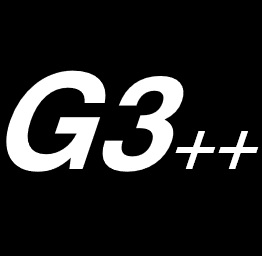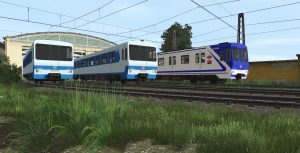Part 2 of the Metro Madrid 5000 Series pack. Jump to the previous or next part.



 From left to right: original livery with the Madrid Metro Company “CMM” logo, original livery with the Madrid Metro “rhombus” logo (post-1986 subway takeover by CRTM) and the “standard” blue and white livery introduced in the late 1990s.
From left to right: original livery with the Madrid Metro Company “CMM” logo, original livery with the Madrid Metro “rhombus” logo (post-1986 subway takeover by CRTM) and the “standard” blue and white livery introduced in the late 1990s.
DOWNLOAD
All the necessary dependencies are either included in this package or are avaible on the DLS. Soundscript by Rizky_Adiputra.
Missing a tracksound? Download this.
This second order of 5000 Series trains for the Madrid Metro came to be in the early 1980s due to the urgent necessity to expand the then-extremely overstretched fleet of wide-profile trains. Indeed, at the time, the “original” 5000 Series fleet, counting sixty-five 2-car sets (130 cars), intended for Line 7, had been stretched far beyond practicality to cover the other wide-profile lines that had rapidly opened soon after (Line 6, from Quatro Caminos to Pacifico and later even to Oporto, Line 8 from Nuevos Ministerios to Fuencarral and Line 9 from Sainz de Baranda to Pavones), almost five time as much trackage, resulting in very short trains being used, and at quite long service intervals.
This situation was an unintended, but easily forseeable consequence of the functional divorce between network expansion and fleet expansion that had been in place for the Madrid Metro since the 1960s: planning, financing and constructing new subway extension had been taken over by the Central Government, but the Madrid Metro Company (“CMM”), an historically insolvent institution, had been left with the task of procuring the rolling stock on it’s own, leading to the need, due to financial constraints, to make either under-sized oders or just order enough rolling stock for the most immediate to-open lines as was with the case of the 1st batch 5000 Series trains – essentially purchased to cover Line 7’s needs. This came to a head in the mid-1970s and early 1980s, as state-financed extensions and new lines opened in rapid sequence, but CMM did not have enough available rolling stock to operate services on them.
With CMM on the brink of financial collapse, the newly-democratic spanish government (wich had succeded the fascist falangist state after Francisco Franco’s death in 1975) placed the company under the supervision of a steering committe nominated by the Ministry of Transportation, wich immediately drew up and adopted a near-emergency funding and renewal plan. While the most notable item in the plan was the “creation” of a successor to the “Clasicos” trains on the narrow-profile network (wich would eventually become the 2000 Series), a good deal of care was given also to the wide-profile lines, with the committee recommending a purchase of a new batch of 5000 Series trains, especially for Line 6, whose ridership was quickly growing, rather “peripheral” lines 7, 8 and 9.
Due to the urgent need for new rolling stock, not many modifications to the 5000 Series’ base design were made, with the most notable one being the traction control system, with the older AEG-made rheostatic contactor-control system being ditched in favour of a more modern chopper control, also made by AEG (and whose design had been extensively tested thruought the late 1970s on a narrow-profile 1000 Series car). Other notable modifications are comparatively minor in nature, among wich a change in placement of the headlights (placing them slightly higher than those on the 1st-batch trains, wich were nearly level with the coupler) and in the passenger window frames – from metal to rubber.
Bodyshell and final assembly was again contracted out to CAF, but this time (unlike with the 1st batch), the whole of the necessary electrical equipment would be provided by the West-German AEG, including the traction motors (wich had been previously procured from General Electric Espanola).
Classified as the “5200 Series” but officially known as the “2nd-batch 5000 Series”, the first sixteen 2-car sets (32 cars) out of a planned 65-set order (130 cars, thus doubling the existing 5000 Series fleet) was delivered in 1982, and immediately entered service, with trains being mainly assigned to Line 6 services. The rest of the fleet (fourty-nine 2-car sets or 98 cars) would be delivered gradually in the following year, up until late 1983.
As part of the arrival of the 5200 Series, the 1st-batch 5000 Series was “shuffled” around slightly, being mostly reassigned to the lower-ridership “peripheral” Lines 7, 8 and 9, with only a small minority persisting on Line 6. To the contrary, the 5200 Series fleet was concentrated and thus mainly used on Line 6, with occasional services also on the other wide-profile lines (namely Line 7).
Unlike the 1st-batch 5000 Series, of wich some trains were extended with trailer cars “inherited” from the abortive purchase of a third 5000 Series batch, the 2nd-batch 5200 Series would “live” the following 25 years in relative tranquillity, with the only notable change coming in the late 1990s, as the new Madrid Metro standard white and blue livery started to replace the original two-tone light blue one introduced in the mid-1970s by the 1st-batch trains.
Thruought the years, Line 6 had quickly become Madrid’s most used subway line, thus in the mid-2000s, an upgrade program for the line was started, wich included the retrofitting of a new, heavier-duty, rigid catenary system and most notably, the replacement of the fixed-block signalling system with CBTC and the replacement of the 1st-batch 5000 Series fleet (wich at the time had grown slightly, mainly due to the influx of ex-Line 9 rolling stock replaced by the newer 6000 Series). As part of this, the 2nd-batch 5200 Series were retrofitted with the necessary CBTC equipment, remaining in service on Line 6 well past the retirement of it’s older predecessors in 2011 (at the hands of the CAF-built 8000 Series).
However, an abrupt end came for the 5200 Series’ career in early 2018, when the whole fleet was preventively retired (and replaced by a melange of rolling stock transferred from other wide-profile lines) as sizeable quantities of asbestos were found to have been used in the interior fittings and undefloor equipments.
Confronted with the choice of performing an expensive (million-of-euros-per-single-car expensive!) asbsestos-removal for the now nearly-40-year-old and discreetly life-expired fleet (whose replacement was already planned in the medium-term) or more simply, aknowledge the situation and officially withdrawn the asbestos-laden rolling stock, Madrid Metro reasonably choose the latter option, with the retirement of the 5200 Series being formalized in April 2018, with the withdrawn fleet being sent to a specialized firm for decontamination and scrapping.
Trivia:
Perhaps one of the most notable “incidents” in the otherwise mundane career of the 5200 Series happened in January 2018 (thus right a few months before the abrupt retirement of the fleet) at Puerta del Angel station, on Line 6. It so happened that a group of graffiti writers was in the midst of “bombing” one 5200 Series set, only to be met by the disgruntled driver, who then proceeded to righteosuly spray them with a fire extinguisher.
Note 1: note the red pilot lamp above the cab door – the graffiti writers were onboard the train, and pulled the alarm while the train was stopped at the station, preventing it from departing, a strategy to gain more time to paint graffiti.
Note 2: the guy recording the video, upon seeing the driver unleashing the fire extinguisher at the graffiti writers, for some reason starts yelling out something along the lines of “man, they’re teens, [please don’t] they’re just teens” to wich the driver (unfortunately barely audible) rightfully retorts with something to the effect of “fuck you too”.
